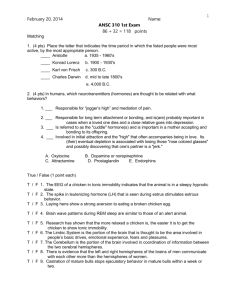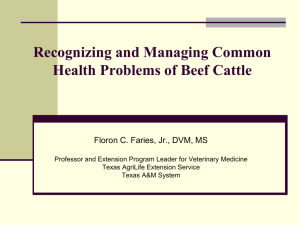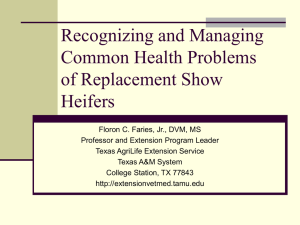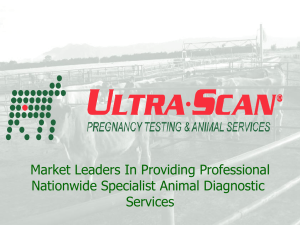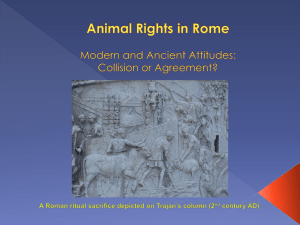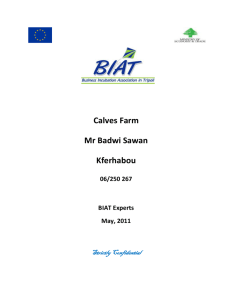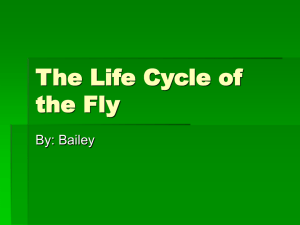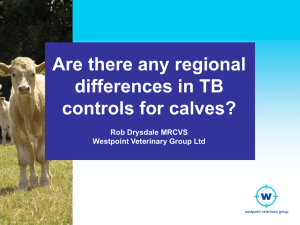vaccination
advertisement
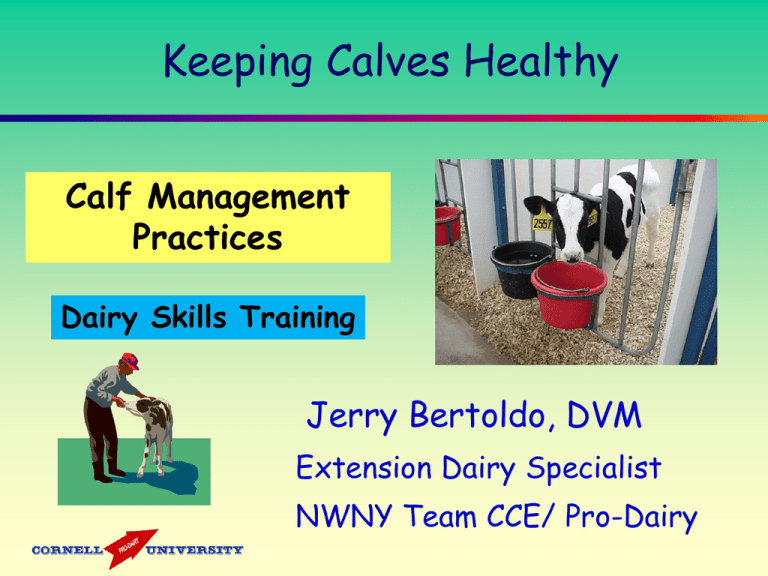
Keeping Calves Healthy Calf Management Practices Dairy Skills Training Jerry Bertoldo, DVM Extension Dairy Specialist NWNY Team CCE/ Pro-Dairy Health Triad Causes of Mortality scours respiratory Wet calves 56.5% 22.5% Weaned calves 12.6% 46.5% NAHMS 2007 Does Infection = Disease? NO! Does Vaccination = Immunity? NO! Primary and Secondary Immune Response Titer Response (Anamnestic or Booster Response) 2nd exposure Memory Cells 0 14 21 28 35 Time in days from 1st antigen exposure Vaccination The Act of Administering a Vaccine Immunization Occurs following vaccination when a response can be measured. Protection Occurs when a properly immunized animal is protected against a specific disease following vaccination. Vaccine use Maternal antibody interference is largely dissipated by 2 months of age Vaccination programs should be based on history and risk of disease introduction Calf raisers adopt early administration by necessity MLV Vaccines Advantages Disadvantages Rapid protection May cause abortion One dose? No sunlight exposure No adjuvant Better CMI and mucosal “Cleaner” product Less expensive Mix and use rapidly Inactivation with residues Possible viral contamination Killed Viral Vaccines Advantages Disadvantages Safe on all pregnancies More hypersensitivity Stability Multiple doses needed for protection Ready to use Use as needed Little or no CMI or mucosal protection More expensive Vaccination precautions The 1st time use of E.coli, Salmonella, Pasturella, Hemophilus and Moraxella vaccines can be associated with delayed allergic reactions particularly in Holstein and Jersey cattle Limit vaccinating to two bacterial components per time Separate from next one by 7 days Do not use 5 way Lepto on calves GOOD IMMUNITY CAN BE OVERCOME BY POOR MANAGEMENT!! Vaccination failures – 5 to 15% Maternal antibody interference Age – under 5 days old Stress (cortisol) – too hot, dehorning Poor nutrition Improper vaccine handling Following directions – IM, SQ, how deep??? Vaccination alternatives Intranasal – Nasalgen, Onset Little maternal antibody interference Quick response Safe at very young age Possible wider spectrum of effect Oral – Calf Guard, First Defense Timing just like colostrum Behavioral patterns for wet calves vary by age Lying down (73-81%) with age (55% lying in daylight vs. near 100% at night) Standing (4.4-11.4%) with age Eating (1.4-5.5%) levels off after 2nd wk Grooming (2.5–4.5%) with age Investigating (0.2-2.9%) with age Contacting pen (2.7-9.0%) peaks in 3rd wk Bedding Choices Wood shavings Straw Sawdust Pea gravel Sand Crusher fines Paper by-products Harvest by-products Wood shavings (+) (-) Absorbent Variability Comfortable Availability Insulating Cost Low initial pH Supports coliform growth Limited fly support Clean hair coats Sawdust (+) (-) Absorbent +/- Variability Comfortable Lung irritation Insulating Supports coliform growth Low initial pH Limited fly support Cheaper than shavings Less nesting ability Dirtier calves Straw (wheat is best) (+) (-) Fairly absorbent Worst for flies Comfortable High streptococcal growth Best nesting Best insulating Availability Low initial pH Cost Clean calves Sand & Pea gravel (+) Comfortable Cheap? Does not support bacterial growth Good drainage (-) Dirty calves Not for cool to cold weather Best for fly control Weight dictates mechanical handling Great base material Variability of quality Paper by-products (+) (-) Comfortable +/- Dirty calves Cheap? Compresses readily Absorbent Wet surface Can use with straw and shavings Variability of quality Dusty at times Baby calves and parasites Nematodes, lice, mange and ringworm can be transmitted from adults or their environment, but are less problematic than flies Exposure to sunlight, nutritional status, whether housed in groups or alone and contact with older cattle determines infection Flies are dependent on environment alone Flies House fly Stable fly Horn fly Face fly Cattle grub fly Horse fly Deer fly House (Musca domestica) and Stable flies (Stomoxys calcitrans) are the major problems around buildings Horn, face, horse, grub and deer flies are most prevalent in pastured cattle Diagnostic Work Quantitative bacterial counts on colostrum, waste milk, pasteurized milk and rinse water from cleaned feeding equipment Culture potential contaminated areas such as calf “hot box”, transport vehicle, area under feed and water Diagnostic Work Check for water hardness and coliforms Check forages for mycotoxins, pH and digestibility How many deaths are posted and sampled? Live calf sampling for pathogens Screening for BVD, BLV, mycoplasma, salmonella Zoonotic Diseases for man and beast! Crypto Campylobacter Salmonella Lepto Ringworm Mange Feed Additives Milk replacer antibiotic (NT) inclusion rates to change Early and late wet period strategies Better to have cocci control in milk replacer than antibiotic MOS products generally give payback Probiotics can be helpful Feed Additives AS700, Aureomycin, Aureo+Bovatec Good management or crutch? Organic/chelated minerals up to 50% High iron, hydrogen sulfide or sulfates Animal source proteins Serum, blood meal Welfare Issues Depends on your perception Ease of identification and visibility by public increases concern Dairy world has an acclimated view of many welfare issues Includes trucking, handling, noise, teat removal, vaccinating Tail Docking Aid or substitute for cleanliness? Public views as mutilation and unnecessary (like dogs?) No research to show any benefit A loosing battle? Tail Docking - Banding Best < 21 days of age – shorter sensitivity period Close-up heifers minimal effect Local/epidural anesthetic of little value Cortisol (stress) response no different than restraint response Possible chronic pain – neuromas number of flies on hind quarters Dehorning Great variation in possible effect Younger the better Restraint is as big a player as pain Easier position to defend than tails Paste Dehorning Used to be a sloppy, poor method Newer products have better consistency Key = early, clip, right spot and amount Minimal stress, mostly from restraint Hot Iron Dehorning Younger is better Painful and stressful without medications Lidocaine = 2-3 hours of pain relief The effect of restraint is equal to that of pain Need sedative, local anesthetic and anti-inflammatory to stop impact Mediating Pain Little effort in the industry to deal with post procedural discomfort Banamine (fluniximine) only practical drug IV should be only administration route Half life is only 8 hours Must be repeated every 24 hours Raising baby calves is one of the toughest challenges on the dairy! Special nutrition Naïve immune system Pathogen exposure Weather variations A host of stressful events They are bovine infants!!
